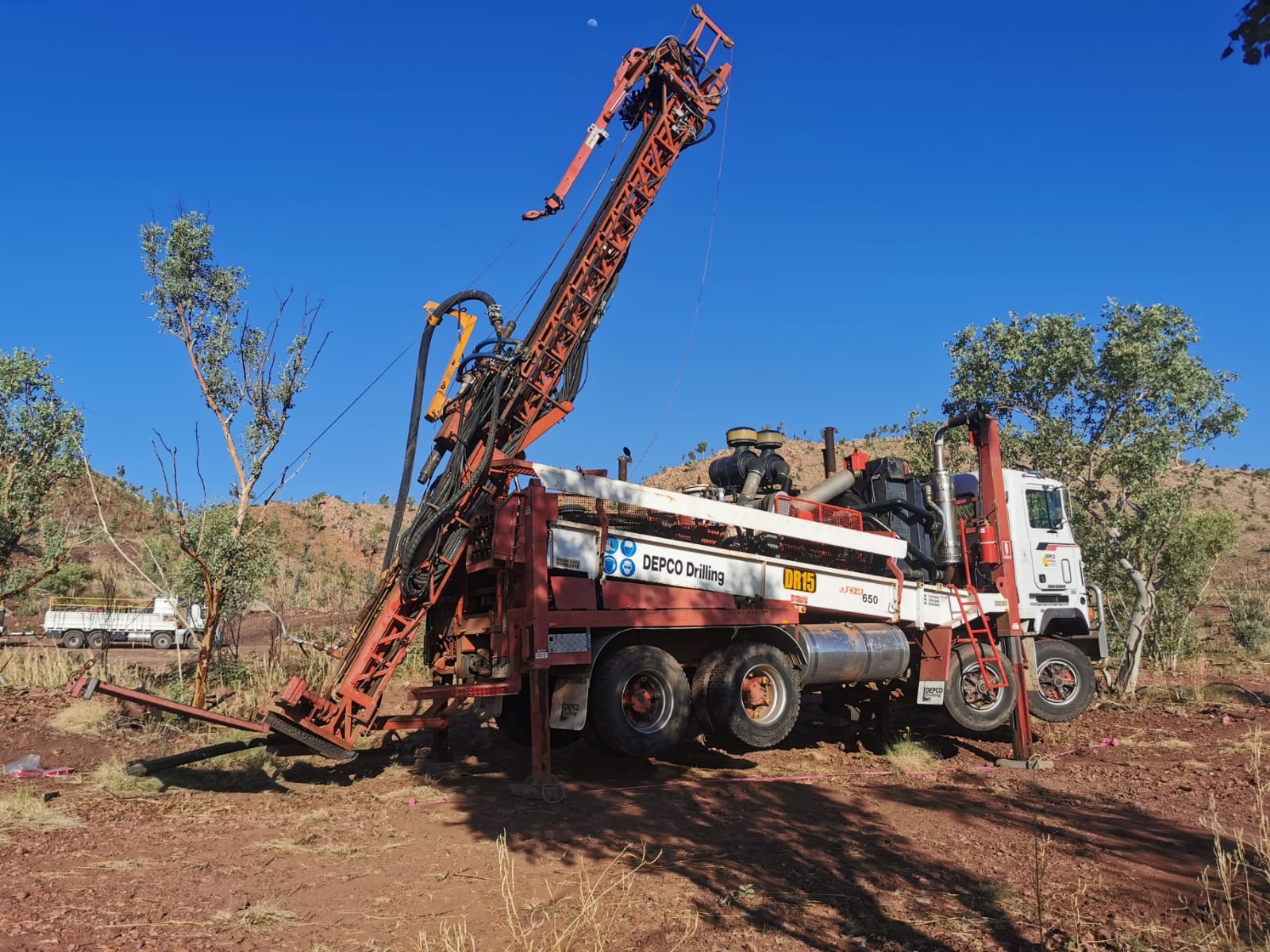Castillo Copper Limited (LSE and ASX: CCZ), a base metal explorer primarily focused on copper across Australia and Zambia, announces that following a review of prospects within the NWQ Copper Project (Appendix A), has authorised the geology team to visit several prospects – including Big One, Arya and Valparaisa – during 1H 2023 to identify new targets for test-drilling.
HIGHLIGHTS:
- Initial focus will be on the Big One, which has an inferred Mineral Resource Estimate (MRE) of 2.1Mt @ 1.1% Cu for 21,886kt (1) copper metal post-two drilling campaigns across 2020-21:
- Factoring in a large conductor north of the line of lode, plus reconciling available geophysics and geochemical data, Castillo’s geological consultant has set an Exploration Target that ranges from 2-6Mt @ 0.6-1% Cu for 12-60kt copper metal*
- The Valparaisa Prospect comprises copper mineralisation across two horizons over a 6km strike event, with the interaction of two intersecting faults suggesting a structurally controlled copper system that can potentially be drill-tested (2)
- At the Arya Prospect, there is a significant magnetic anomaly, south of a known graphite system (3) (test drilled in late 2021), that shows potential to be a primary source of copper mineralisation
- Meanwhile, final drill and auger assays, which are still pending, should define the potential scale of the rare earth element discovery at the BHA Project’s East Zone
Dr Dennis Jensen, Managing Director of Castillo Copper, said: “With the macro-outlook for copper remaining upbeat, the Board has authorised the geology team to visit several prospects to identify new targets to test-drill. Key areas of focus include increasing the grade and confidence in the current MRE at Big One and the magnetic anomaly at the Arya Prospect. Given the large size of the NWQ Copper Project, the Board remains open to aligning with a strategic partner to further advance development work.”
* Cautionary Statement: It should be noted that the Exploration Target tonnage range quoted above are conceptual in nature and there has been insufficient exploration to define a copper resource. Although a preliminary analysis was undertaken, insufficient data exists to confidently correlate mineralised horizons within the Exploration Target area. It is uncertain whether further exploration may lead to the reporting of a JORC-standard resource, however, there is some evidence to support the current exploration tonnage calculations, and the sufficient mineralised thicknesses interpreted from historical drilling to warrant further investigation in some areas.
NWQ Copper Project – Site Visit
A summary of salient points from the review for the three prospects highlighted follows:
Big One
Whilst some areas around Big One were drill-tested in the 2020-21 drilling campaigns, much of the area remains under-explored which highlights the exploration potential.
Utilising information from Castillo’s drilling campaigns, complemented with historical data, Castillo’s geological consultant compiled an extensive database, built a block model, and produced a maiden 2012 JORC Inferred MRE at 2.1Mt @ 1.1% Cu for 21,886kt copper metal (1) (Figure 1).
FIGURE 1: MINERAL RESOURCE TONNAGES BIG ONE COPPER MINE
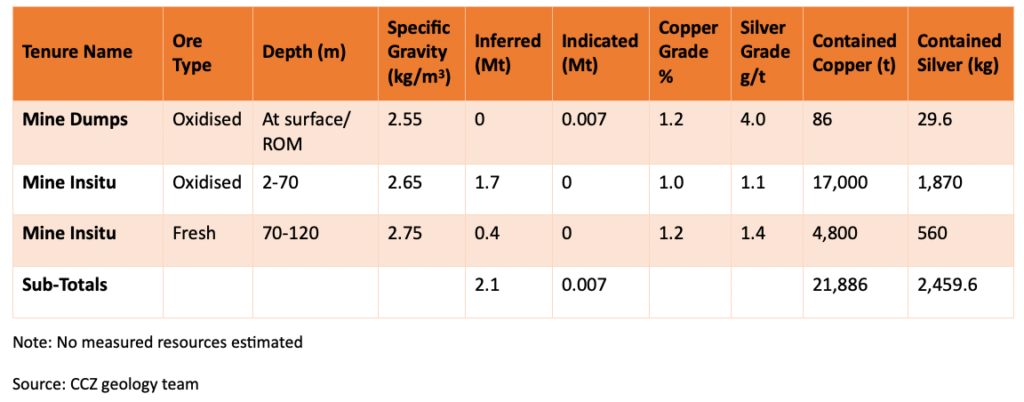
Building on this work, the geology team believe further drilling is warranted along the known orebody to the east, north and downdip as it is not fully defined. Specifically, the geology team believe a well-designed drilling campaign – focussing on diamond coring – has the potential to materially increase the grade and confidence in the current MRE, as the orebody is open to the east and downdip.
In addition, an Exploration Target* (to the standard of Clause 17 of the 2012 JORC Code) has been estimated utilising the following information:
- the MRE plus some areas proximal to and downdip to the main resource shell; and
- available geophysics and surface sampling data.
The Exploration Target’s* mid-range is 4Mt @ 0.6-1.0% Cu, with the low at 2Mt and high at 6Mt – refer to Figures 2 and 3. It should be explained that this is an enlarged range of tonnage compared to the MRE due a new wireframe model extended along the entire line of lode.
* Cautionary Statement: It should be noted that the Exploration Target tonnage range quoted above are conceptual in nature and there has been insufficient exploration to define a copper resource. Although a preliminary analysis was undertaken, insufficient data exists to confidently correlate mineralised horizons within the Exploration Target area. It is uncertain whether further exploration may lead to the reporting of a JORC-standard resource, however, there is some evidence to support the current exploration tonnage calculations, and the sufficient mineralised thicknesses interpreted from historical drilling to warrant further investigation in some areas.
FIGURE 2: BIG ONE – EXPLORATION TARGET *

FIGURE 3: BIG ONE – EXPLORATION TARGET FOR COPPER *
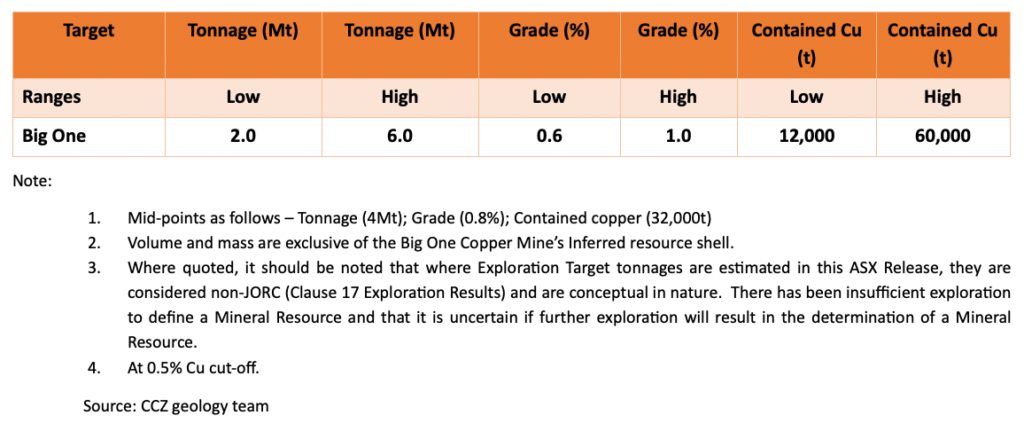
* Cautionary Statement: It should be noted that the Exploration Target tonnage range quoted above are conceptual in nature and there has been insufficient exploration to define a copper resource. Although a preliminary analysis was undertaken, insufficient data exists to confidently correlate mineralised horizons within the Exploration Target area. It is uncertain whether further exploration may lead to the reporting of a JORC-standard resource, however, there is some evidence to support the current exploration tonnage calculations, and the sufficient mineralised thicknesses interpreted from historical drilling to warrant further investigation in some areas.
Valparaisa Prospect
The Valparaisa Prospect comprises copper mineralisation in two horizons – termed the “upper and lower copper beds” – within the Middle Gunpowder Creek Formation over a 6km strike length (Figure 4). Compared with the ‘upper bed’ the ‘lower bed’ has the stronger outcrop and more copper staining (2).
Previous explorers, including BHP, undertook rock-chip sampling which returned high-grade assay results up to 2,530ppm Cu, demonstrating prospectivity at surface for copper mineralisation (2). Interestingly, the surface anomalism aligns with the interaction of two intersecting faults – Mt Gordon (SW-NE – links to Mt Mammoth Deposit) and Valparaisa (SSE-NNW).
Reconciling and interpreting the foregoing facts has postulated that there is a structurally controlled copper system at the Valparaisa Prospect.
FIGURE 4: VALPARAISA PROSPECT – SOLID GEOLOGY, ROCK CHIPS & DRILLHOLES
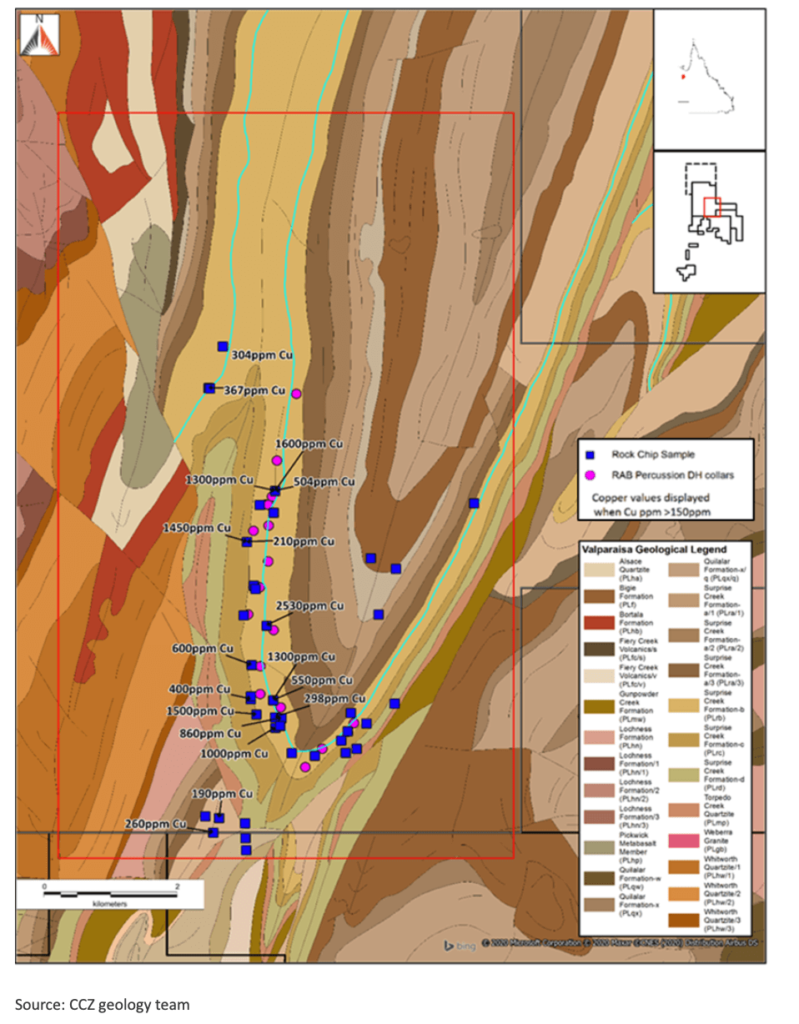
In terms of identifying potential targets for closer scrutiny, a key positive was identifying the Whitworth Quartzite rock formation within the Valparaisa fault. This is significant as it hosts copper sulphide mineralisation within the Mt Gordon fault at the Mt Mammoth Deposit. Reconciling this against overlaid magnetic imagery, enables several target areas for structurally controlled copper and supergene ore mineralisation to be generated (Figure 5).
FIGURE 5: STRUCTURALLY CONTROLLED AND SUPERGENE TARGETS
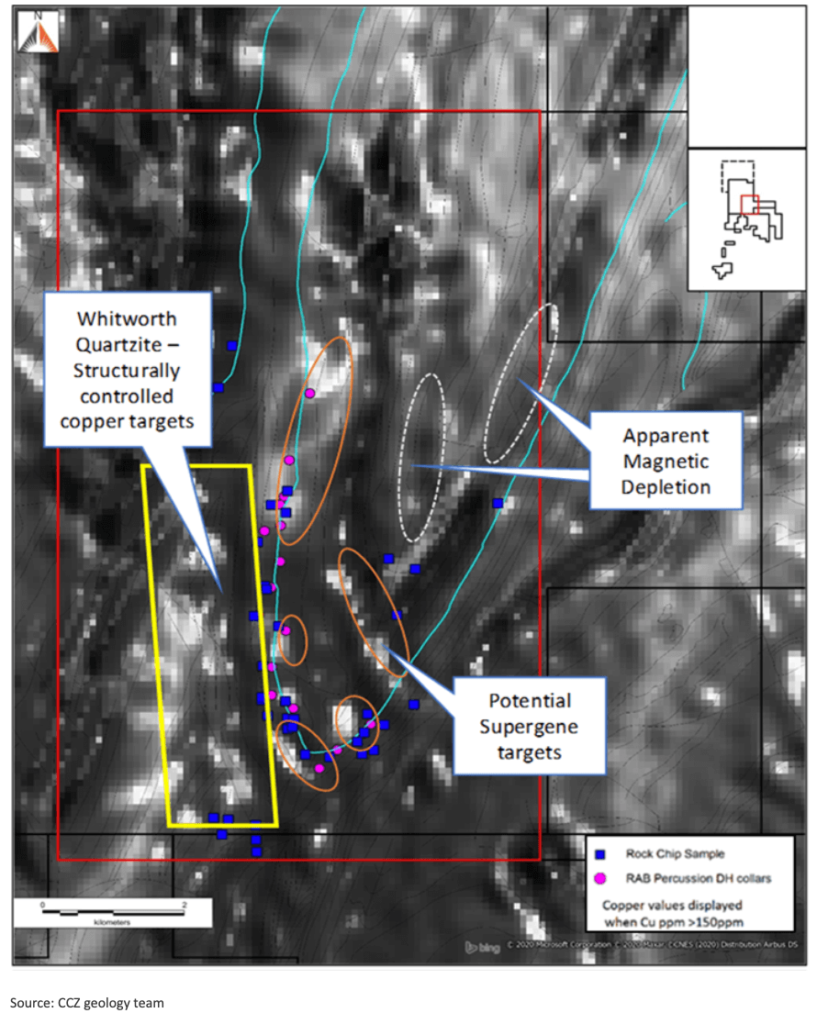
Arya Prospect
A limited drilling campaign in late 2021, designed to test several large airborne electro-magnetic and ground resistivity anomalies, confirmed a low-grade graphite system that won’t be further explored (refer Appendix B for assay results).
However, a sizeable magnetic anomaly – south of the known electro-magnetic anomalies – is interpreted to be associated with known surface copper and to a lesser degree silver mineralisation. A key focus of the site visit is to determine if this should be drill-tested as it may be a primary source of base metal mineralisation at the Arya Prospect.
In terms of regional geology, the Arya Prospect is located in the Western Mt Isa Succession, within a structurally deformed and copper anomalous district that hosts the Capricorn Copper Mine, Mt Oxide Mine and the Ladie Annie Mine. These are hosted within units of the upper Myally sub-group to lower McNamara Group, while the Arya Prospect is hosted within the Surprise Creek formation (Figure 6).
FIGURE 6: STRATIGRAPHIC COLUMN
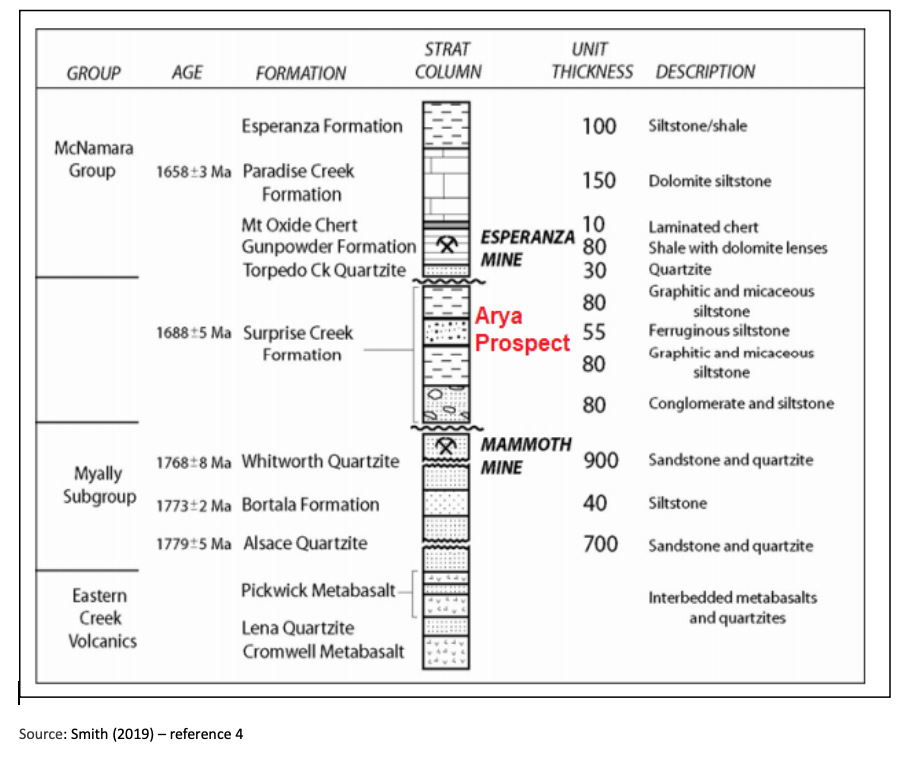
In terms of local geology, the Arya Prospect is located within the Surprise Creek Formation unit (Prd), with several results from rock-chip sampling indicative of a structural system for anomalous copper values (Figure 7). Moreover, the Arya Prospect is proximal to an east to north-east trending fault that offsets the Surprise Creek unit (Prd) from lower units near the base of the Surprise Creek Formation, and Myally Sub-Group units, including quartzites, and sandstones.
FIGURE 7: COPPER GEOCHEMISTRY ON QUEENSLAND GOVT GEOLOGICAL MAP
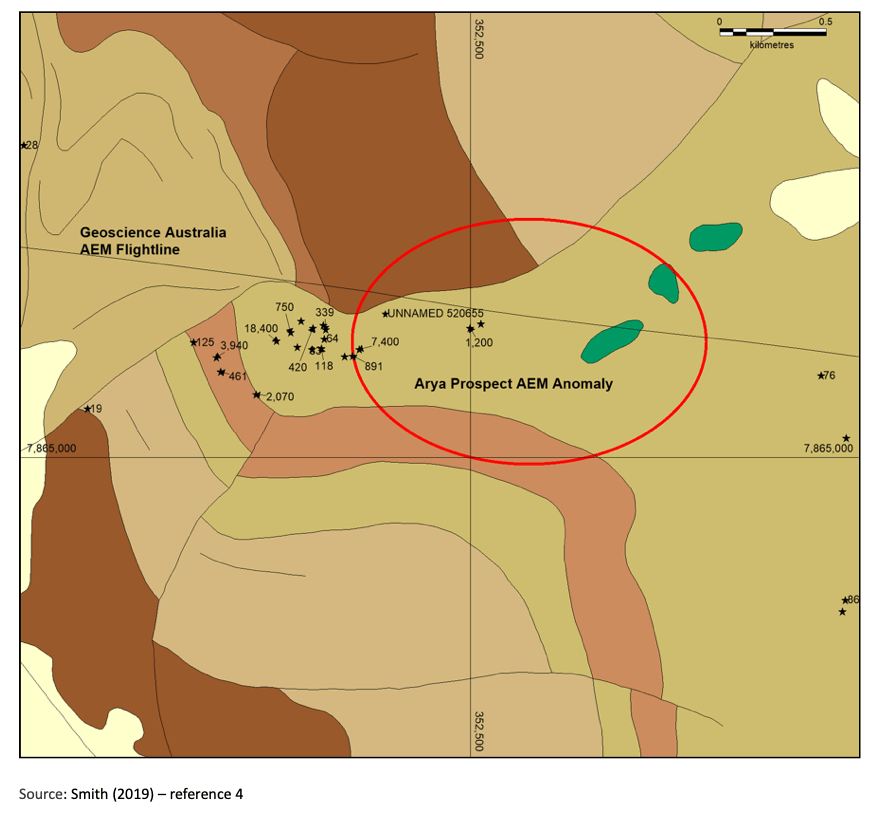
Interpreting these findings, suggests probable mineralisation styles include:
- Supergene mineralisation forming at the surface along the fault, fault breccia, and the Surprise Creek Formation (PLrd) rock unit.
- Epigenetic replacement mineralisation for Cu (with minor components of other base metals and gold) from replacement carbonate mineralisation, particularly the Surprise Creek Formation.
- Skarn mineralisation for Cu-Au and/or Zn-Pb-Cu from replacement carbonate mineralisation, particularly the Surprised Creek Formation.
- Sulphide mineralisation within breccia zones, along stress dilation fractures, emplaced within pore spaces, voids, or in other rock fractures; and/or dykes.
Main ore minerals observed comprise:
- Malachite and chrysocolla along foliation, in brecciated/strongly haematitic sedimentary rocks.
- Quartzite/rhyolite with chrysocolla on joint surfaces and fractures, circa 3-5% Cu.
- Malachite and azurite on joint planes in porous sandstone.
References
- CCZ ASX Release – 28 February 2022
- CCZ ASX Release – 7 September 2020
- CCZ ASX Release – 10 August 2021 & 17 November 2021; 28 January 2022
- Smith P., 2019, Ayra Mt Oxide prospect, unpublished report by Yoda Consulting Pty Ltd to Castillo Copper Limited, Apr 2019, 15pp.

